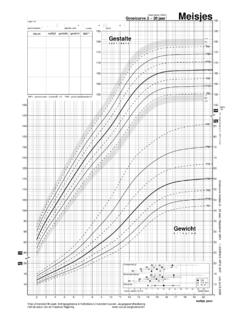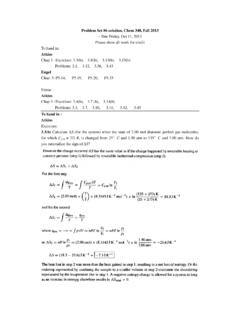Transcription of 15 In Hubble’s shadow: early research on the expansion of ...
1 15In Hubble s shadow: earlyresearch on the expansion ofthe universeHilmar W. DuerbeckUniversity of Brussels (VUB)Pleinlaan 21050 BrusselsBelgiumWaltraut C. SeitterMuenster University48149 MuensterGermanyAbstractAn overview on the progress of theoretical and observational cosmology inthe first half of the 20th century is given. We outline the Einstein, de Sitterand Friedmann-Lema tre models, and describe the quest forthe observationalconfirmation of the de Sitter universe , as well as the first theoretical andobservational work on the Friedmann-Lema tre universe .
2 We analyze theattempts to determine the expansion parameter, and trace early research onthe deceleration HUBBLE S Relativistic cosmology and the The beginningsIn 1917, about a year after the introduction ofGeneral Relativity(GR), Ein-stein [1] and de Sitter [2] published papers on the application of GR to theuniverse. Encountering problems in finding meaningful boundary conditionsat infinity, Einstein had the remarkable idea to circumvent the problem byenvisioning space as curved and closed. Both Einstein and deSitter assumedthat the universe is constant in size, a hypothesis which wasacceptable at thattime.
3 Einstein assumed that only space is curved; de Sitter took time as com-pletely equivalent to space, and assumed a constant curvature of on the choice of coordinates, de Sitter s model permits differentinterpretations. His original solution was written in time-independent, staticcoordinates, which leads to the following phenomena: (1) time flows withdifferent speed at different points in space, and (2) there exists an event horizon, where the time flow becomes infinitely the Einstein and the de Sitter universe included a universal constant,which had not been necessary in original GR, but which is, however, neededin static relativistic universes.
4 This cosmological constant correspondsto an energy density, which is not connected with matter, andthus must bea property of the vacuum. The nature of asvacuum energy densitywasalready recognized by de Sitter in 1917, and put on more solidground byLema tre [3] in 1934. Today we assume that vacuum is a quantum vacuum,whose energy density plays an important role in the formation and earlyhistory of the universe (and possibly up to the present time).In 1922, Friedmann [4] showed that there are no further solutions of theequations of GR including , which describe universes whichare constantin time, but he suggested other interesting solutions whichwill be No cosmological redshift in the EinsteinuniverseEinstein s universe is based on the assumption that matter is distributedhomogeneously on large scales, and does not show large-scale motions.
5 Thiswas the first formulation of the cosmological principle of general homogeneityand isotropy. No large-scale variations of gravitation exist, and no redshiftdue to gravity does occur. The total sum of masses is in Mach s sense the cause of inertia. The assumption of small velocities takes care of the factthat also the second relativistic spectral line shift, the Doppler effect, whichRELATIVISTIC COSMOLOGY233had been formulated precisely inSpecial Relativity, remains small: Einstein suniverse is a world without cosmological spatial geometry of Einstein s world model can be visualized as apositively curved hypersphere, a three-dimensional analog of a spherical sur-face, of limited extent, but without boundary.
6 The curvature of space andthe curvature radiusRas a measure of its extent are both constant. Thecurvature of Einstein s matter-filled universe is determined by the invariantmatter-density, or by the positive cosmological constant that is necessary tokeep it from collapsing. The larger the matter density, the smaller is thecurvature radius. The cosmological constant counteracts the gravitationalattraction of the masses; it avoids a gravitational collapse of the as the fourth dimension flows with equal speed at all points. Infive-dimensional euclidean space, the space-time-continuum appears as a four-dimensional cylinder which extends in the time-axis from minus infinity toplus infinity (the Einstein universe is synonymous with the cylindrical uni-verse).
7 Each light ray describes a spiral curve on the surface of the four-dimensional cylinder. Depending on distance (and thus light-time) we observetoday sections of time-invariable three-dimensional space (the hypersphere),how they appear at different times. If we would be able to determine distancesof objects associated with these sections, and if these would not undergo tem-poral changes, we would be able to have a look at the complete history of theuniverse, as a sum of all sections. But such a task would be extraordinarilydifficult in Einstein s universe , there is no redshift that can be used as adistance Redshift in the de Sitter universeThe geometry of the de Sitter universe is conceptually more complicated thanthe Einstein universe , since not only the three space coordinates, but also thetime coordinate is included into the curvature of space-time: this space-timehas a higher symmetry than the space-time in Einstein s universe .
8 In five-dimensional euclidean space, the space-time of constant curvature appearsas a four-dimensional one-shell hyperboloid, which extends for each observerfrom minus infinity to plus Sitter postulated a matter-free universe , matter-density is equal tozero; only the cosmological constant (energy-density) is present and causes thecurvature. He assumed the galaxies as probe particles whose masses are toosmall to influence the curvature of space-time. While in the matter-filled Ein-stein universe , collapse can only be stopped by introducingthe cosmologicalconstant, the de Sitter universe , with its positive cosmological constant andnegligible amount of matter, possesses an overwhelming tendency to expand,234IN HUBBLE S SHADOW forcing the galaxies to move away from each other and from galaxy particles in the de Sitter universe appear to bein acceleratedmotion away from the observer.
9 De Sitter re-introduced the Doppler effectinto types of redshift exist in the de Sitter universe : one is the Dopplereffect, which occurs between the dispersing galaxies, another one is the cos-mological redshift which is based on the structure of space-time. If the realworld would be a de Sitter universe , the combination of both effects should beobservable in the spectra of distant celestial objects. In the following sections,thede Sitter effectwill encompass the sum of both redshifts. The de Sittereffect should increase in anon-linearway with distance from the 1917, the extragalactic nature of spiral nebulae was not yet , these objects were de Sitter s best candidates for large assumption was supported by Slipher s radial velocity measurements ofthree spiral nebulae, which had just come to his attention.
10 De Sitter [2] wrote:If [.. ] continued observation should confirm the fact that thespiral nebulae have systematically positive radial velocities, thiswould certainly be an indication to adopt the hypothesis B (deSitter- universe ) in preference to A (Einstein- universe ). Alternative interpretations of redshift in thede Sitter universeIn 1918 Einstein [5] criticized the de Sitter model in pointing out that thede Sitter universe is not empty, and that it has a horizon. This horizon isanaloguous to the horizon in the vicinity of a point mass, which was studied,in 1916, by Karl Schwarzschild [6] in the framework of GR.








